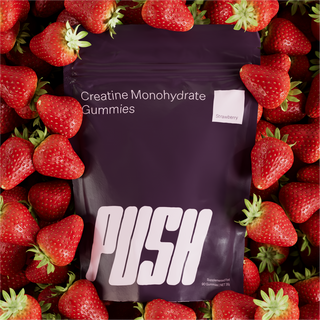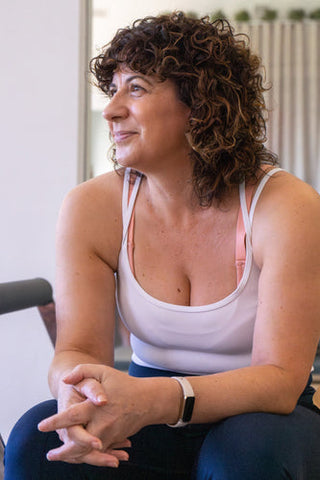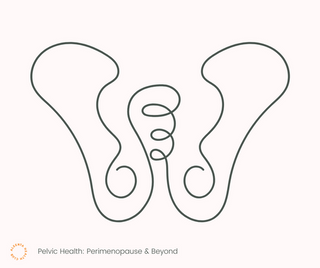Positive ways to help your body through the change
Isn't it crazy how so many naturally occurring events in a women's life are so quickly swept under the rug and thought of as taboo? Periods? Shh. Female sexual desire? Next topic, please. Menopause? Gosh no!
Thankfully, as a society, we are moving away from this ridiculous need to keep normal bodily functions a secret and are instead beginning to normalise chatting about things that happen to 50% of our population.
Menopause is perhaps the most taboo of these subjects, which leaves many women feeling as though they have to suffer in silence. At Aleenta, we are here to tell you that this is no longer the case and want to provide some tips, tricks and advice to help you keep that fabulous body of yours moving through this change.
Normalising menopause as a topic of conversation is everyone's responsibility, including women of all ages and men. Just like it is inevitable that you will ugly-cry through Marley and Me, it is inevitable that everyone who menstruates will eventually go through menopause. Levelling up your knowledge around the topic not only means you are prepared for when the changes start to happen in your body, but you are also there to support the women in your life going through menopause themselves.
As we discuss different exercise considerations for menopause, it is important to remember that you are not alone. Finding a sense of community in this monumental life change will help guide you through the process, and it is more important than ever to be tender with your body. As with anything, don't let any questions, concerns or abnormal symptoms be swept under the rug, and don't be afraid to ask your OB-GYN or GP for support.
Menopause Basics
Let's do a quick round the grounds on menopause, and its many components.
What is Menopause?
Put simply, menopause signals the end of menstruation and occurs when you haven't had a period for 12 months. Most women will reach menopause between 45 and 55, with the average age in Australia being 51-52. Premature menopause can occur before the age of 44 and can result from surgery, chemotherapy or radiation.
What many people don't understand is that menopause can be broken into four distinct parts.
Part 1: Premenopause
This can begin 8-10 years before menopause. During this time, you will still have periods and won't have any significant symptoms, however, hormonal changes are beginning to take place in your body, in particular, your estrogen levels will start to fluctuate.
Part 2: Perimenopause
Otherwise known as the transitional phase, perimenopause is when you may still be menstruating, but you start noticing some of those lovely menopausal symptoms (more on those later). During this period, around 80% of women will experience symptoms as their hormones are essentially on a rollercoaster, fluctuating without a care in the world. Perimenopause is the key period where hormonal production in the ovaries starts to decline.
Part 3: Menopause
Throw caution to the wind and fling those tampons out the door, as you have now officially stopped menstruating. Diagnosed once you haven't had your period for 12 months, the ovaries have now officially closed up shop and stopped producing enough estrogen for eggs to be released.
Part 4: Postmenopause
Once you have no longer bled for 12 months, you will transition into postmenopause. Symptoms will generally begin to ease; however, some women may still experience symptoms for up to a decade. Now that your body's estrogen levels are consistently low, you are more at risk of certain conditions, including osteoporosis and heart disease (luckily, moving your body will help you reduce this risk!).
Long story short, going through hormones is like riding a very long rollercoaster. Your body essentially goes from having lots of lovely female hormones cycling through your body every day to suddenly having no hormones. These hormones have a massive impact on your body composition and strength, so it is vital to find some exercises that will work for you during this period and beyond.
How do the hormones change during menopause?
A lot is going on in that glorious body of yours during this time. Today we are just going to focus on what's happening with the three main hormones.
Estrogen is the primary female hormone responsible for the growth and health of your reproductive organs (breasts, vagina, etc.). During perimenopause, your estrogen levels will decline in a very irregular fashion. While their end goal is to decrease, your body will experience insane peaks and shallow troughs of estrogen production in your body. High levels will cause symptoms such as bloating, breast tenderness and heavy bleeding. Low estrogen levels will trigger symptoms like hot flashes, night sweats, palpitations, headaches, insomnia, fatigue, bone loss and vaginal dryness. Sounds pretty fun, yeah?
Progesterone is another crucial female hormone that helps regulate your period. Progesterone changes lead to irregular, heavier, and longer periods during perimenopause before your period eventually stops altogether, and progesterone is no longer produced.
Testosterone, otherwise known as the male hormone, contributes to your libido and peaks during your 20s before slowly declining into menopause. Fluctuations in testosterone will impact your sexual desire throughout this period, despite still being produced in small quantities by the ovaries and adrenal glands after menopause.
What symptoms can I expect during menopause?
It's important to remember that everybody is different, so the symptoms you experience may be completely different from those experienced by other women in your life. With this in mind, common symptoms of menopause include:
- Irregular periods
- Night sweats
- Mood changes
- Hot flashes
- Joint pain
- Weight shifts
- Insomnia
- Anxiety
- Depression
- Brain fog
- Short term memory loss
- Unpredictable bleeding
- Headaches
- Weakness or fatigue
- Loss of sexual desire
- Itchy skin
- Feeling teary
- Weakness of pelvic tissue
- UTIs
- Frequent urination
- Hair changes
- Breast tenderness
Disclaimer: If you're sitting here reading this and thinking, 'yikes on a bike, this is some crazy stuff!'. You're right. We're not going to beat around the bush; menopause can be challenging. But, it's so important to remember that you are not alone, and countless women have been through this before you and conquered menopause. You can do this.
Disclaimer for all the men reading: Aren't women bloody amazing (pun most definitely intended). If you're still reading this, give yourself a high five and then give all the gals in your life a high-five. It is so important that you show some empathy and understanding to the crazy shifts that are happening in their body.
Make menopause your b*tch!
How to exercise throughout menopause.
Repeat after me: just because you are going through menopause doesn't mean you need to give up on your fitness goals. It is so, so important that you be kind to your body during this time and listen to what it wants. A little bit of tough love will never go astray either.
Like you varied up your exercise regime during your menstrual cycle (link to other blog here), it is important that you find a balance that supports your body's new needs during all stages of menopause.
Now, the hormonal changes in your body, particularly crazy estrogen fluctuations, will impact a few things regarding maintaining weight and continuing exercise. Expert in the field of ageing and hormones, Dr Tamsin Lewis explains that when estrogen is in excess, your body is more inclined to store fat. Alternatively, when estrogen levels are low, it will impact your metabolism. As a result, many women experience weight gain, particularly around the belly, during menopause.
In addition to this, research has proven that muscle cells begin to disappear as estrogen declines. This can trigger a flow-on effect to the bones, as weak muscles can lead to weak bones. Why? Well, bones are strong when the muscles attached to them are strong, particularly in the hips, spine and arms. Weaker bones will not only lead to fragility, but it increases your risk of osteoporosis.
Finally, lower estrogen levels can also increase your risk of lifestyle diseases, including cardiovascular disease and type 2 diabetes.
Instead of running for the hills waving your bra in the air like a white flag to menopause, consider running in the opposite direction towards a gym, dance class, barre studio (ahem, Aleenta), swimming pool or other forms of exercise that will help combat these increased risk factors.
While there is no substantial research that shows exercise can prevent and combat hot flushes, it has been proven to assist with several other menopause-related symptoms. At the end of the day, moving your body (and having fun while doing it) is never a bad thing, especially when done with other people.
Finding a balanced exercise routine that you enjoy during menopause will:
- Prevent weight gain. Now, we want to highlight that there is nothing wrong with putting on a little weight, especially as your body goes through these changes. However, during menopause, women are prone to losing muscle mass and gaining abdominal fat. Enjoying daily exercise will help prevent this from becoming a major issue.
- Strengthen your bones: as we mentioned above, strong muscles = strong bones. This will help prevent fractures and osteoporosis.
- Lower your risk of lifestyle diseases like heart disease, high blood pressure and type 2 diabetes. This is a fact for everyone, though, not just those going through menopause.
- Boost your metabolism, especially as estrogen levels continue to decrease.
- Reduced lower back pain as you continue to strengthen muscles and move your body.
- Decreases stress and improve your mood. As you exercise, you produce endorphins which lower your risk of depression and cognitive decline, and all round, make you feel great.
Exercise guidelines for menopause: how much and what should I do?
In line with Australian physical activity recommendations, you should aim for 150 to 300 minutes of moderate activity or 75 to 150 minutes of intense physical activity a week. In other words, if you can put aside at least 30 - 40 minutes a day for a mix of intense and moderate activity, then you are doing more than ok.
Menopause affects every woman differently, and we can't stress enough how important it is to listen to your body. With that in mind, the best thing you can do is find an exercise that you love doing. You see, a lot of the time you need the motivation to do 'exercise'. If you are in the middle of a menopause symptom storm, the last thing you'll want to do is shimmy into those tights and trudge to the gym. However, if your form of exercise is a highlight of your day, perhaps shared with friends, then it becomes less of a chore and more of a welcome relief to the hormonal roller coaster happening in your body.
When planning your workouts, there are a few extra things you want to consider. Ideally, you want to include a mix of endurance, strength and balance exercises. It's also a good idea to understand your target heart rate zone to understand your activities' intensity. We've broken down these exercise types below to help you know how to craft your workouts.
TIP: Trying to find the right intensity? Why not try the talk test! When you're doing a moderate-intensity workout, you should be able to talk but probably not sing your favourite song. During vigorous activity, you may be able to say a few words to your friends (i.e. 'not ANOTHER squat', or 'I can't wait for coffee after') , but you won't be able to string a complete sentence together without stopping for a breath. Whatever you're doing, you don't want to be completely breathless.
Endurance & Aerobic Exercise for Menopause
Cardio and endurance-based movement is not only essential to your weekly routine, but it is one of the best exercises for the 'menopause belly.' Better yet, aerobic activity that increases your heart rate and recruits the larger muscle groups like your quads, glutes, and core is a fantastic way to help build strong bones.
The best aerobic exercise for menopause include:
- Running
- Swimming
- Cycling
- Barre
- HIIT
- Boxing
- Rowing
- Cardio machines at the gym
- Dancing
- Group Fitness
- Vigorous house or yard work (pump those tunes and get the Dyson going)
If you're getting back into exercise, start with 10 minutes of light cardio before slowly increasing the time and intensity. Rome wasn't built in a day, so tie up those laces, throw on some goggles or pick your favourite pair of grippy socks and give it a go.
Strength Training Exercises for Menopause
As we have mentioned earlier, the decreasing estrogen levels in your body can compromise your bone and muscle health. With this in mind, it is important you train all of your muscle groups and focus on weight-bearing and resistance based exercises to help build the bone mineral density in your body.
Great weight-bearing exercises for menopause include:
- Reformer Pilates
- Mat Pilates with resistance bands and 1kg weights
- Strength training machines
- Dumbbells and free weights
When targeting the legs, you want to look at squatting and lunging movements; just pay particular attention to your form and ensure you work your way up in weights to avoid injury.
If you are at risk of osteoporosis, consider chatting with an osteopath or physio before deciding on your exercise regime. Remember that bodyweight exercises or exercises with resistance bands or 1kg weights are a fantastic way to move your body.
Balance Training for Menopause
Balance based exercise is a great way to help build your core strength and prevent falls. Not only that, non-impact activities that focus on balance, breathwork and stretching are a great form of stress relief from your menopause symptoms and the general grind of life.
Excellent balance and breathing exercises for menopause include:
- Flow yoga
- Restorative and yin yoga
- Tai Chi
- Gentle pilates
- Meditation
These activities will give you breathing techniques that may be useful when overcoming menopausal symptoms. Better yet, they will help calm your mind and ensure you are taking out some very well deserved 'me time'.
Please note that if you do have osteoporosis, it is essential that you limit activities that have a risk of falling.

Other things to consider when exercising during menopause
Menopause and its stages can encapsulate over ten years of your life, so make sure you find ways to work with your body rather than against it. Consider these tips to help you limit the impact of your symptoms when exercising during menopause:
- Take time to warm up and cool down to prevent injuries.
- Wear light, breathable clothing that you feel comfortable in to avoid overheating.
- Work out in cooler temperatures, whether in the air conditioning or the early morning/later afternoon, to prevent hot flashes.
- Take regular breaks and have access to plenty of cold water.
- Set realistic and achievable goals to ensure you feel that sense of accomplishment.
- Increase your protein intake to help retain muscle mass
- Consider reducing your simple carb intake if you are looking to lose weight.
- Limit smoking and alcohol intake for overall health and to help lessen menopause symptoms like hot flashes and insomnia.
- Avoid working out before bed, as this may increase your chances of insomnia. Instead, consider some gentle yoga, meditation or a warm bath.
- Share the love and exercise with friends and family.
- Focus on working the bigger muscles in your body, like your legs. They are more metabolically active and will help reduce your fragility.
- Be kind to yourself. If you miss a day or two, it isn't the end of the world.
Last but not least, get creative! Whether it means getting creative with your exercise or doing some arts and crafts that you love, being creative will help take your mind off symptoms and help foster a positive feedback loop as you do something you love.
Exercise Considerations for Menopause: You've Got This
Creating a fun and meaningful exercise routine that works for you is an essential part of life, not just menopause. While we can't guarantee that moving that wonderful body of yours will stop some of the less pleasant symptoms like hot flashes, we can ensure that daily movement will help improve your overall health and, most importantly, make you smile.
Above all else, please remember that you are not alone in this journey, and there are countless women out there rooting for you. Menopause is not a dirty word, so please never feel ashamed of your body conquering the next stage of life.
Want workouts designed for those experiencing menopause? Check out Me by Aleenta for curated programs that already align with everything outlined in this blog!







